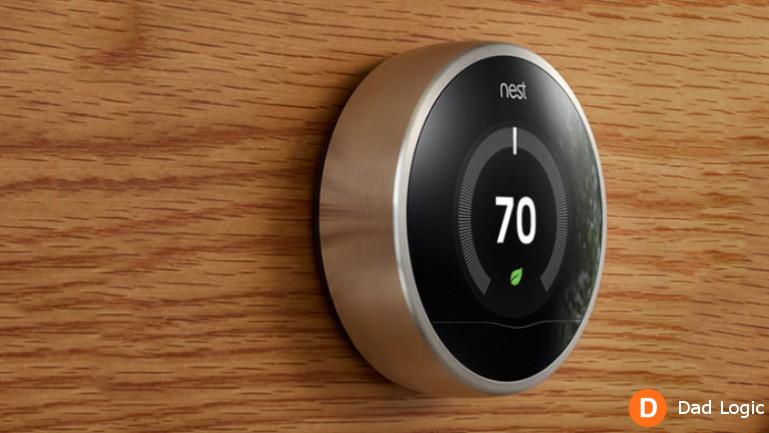On any given weekend, you will likely find me roaming the aisles of our local Home Depot. Usually I stop by because I have something to fix around the house. But this time, I had a stack of gift cards from my birthday that were burning a hole in my pocket. And instead of buying another power tool, I decided to buy a fancy, high tech Nest thermostat.
Over the past few years, I have been working to reduce the amount of energy we use in our home. I switched to energy efficient bulbs throughout our house. I switched to a time of use program which gives us discounted rates based on when we use energy. And with the Nest thermostat, I am hoping to further reduce our energy use by being smarter about how we heat and cool our home.
So here’s what sold me on the Nest thermostat. The thing monitors how your family uses the heating and cooling system, learns from it, and then helps you operate it more efficiently. It has motion sensors that track when you are home and when you leave for work. Within a week or two, it learns your habits and automatically adjusts things so that you aren’t running the air conditioner when no one is home. I found this approach has been more efficient than the programmable thermostat we previously used. We come and go a lot on weekends (and use the most energy on Saturday and Sunday). With Nest, our central air system only runs when we are home and automatically turns off when we head out for family fun.
I was a little bit nervous about the installation process, but that actually turned out to be painless. It honestly took me about five minutes to get the thermostat wired and mounted to the wall. The Nest spent more time downloading a software update than it took me to install the thing. The box came with all of the necessary parts. It even included a screwdriver. When it came time to mess with the wiring, the instructions suggested that I should take a photo of how things were wired with the old thermostat. I then used the included stickers to label the wires before disconnecting the old thermostat. It was really simple.
The Nest has a compact design, so you will likely need to patch a hole in your wall or paint to cover up where the old thermostat was previously. The kit includes a larger square mounting panel that you can use to cover things up, if you don’t feel like patching your wall. But why not do the job right? The thermostat looks neat. There is not much sense in taking away the design aesthetic by using the larger mounting bracket.
After you clip the wires into the corresponding ports (they are all labeled with letters), the Nest lights up and prompts you to connect to your home’s wireless network. You don’t need a WiFi network to make Nest work, but it does make it possible to use many of the thermostat’s high tech features. For example, Nest has an app for your iPhone or Android device that lets you control your thermostat from your smartphone. I have found this is really nice for adjusting the temperature when I am in bed.
From your phone or from the Nest website, you can change your programmed heating/cooling schedule, check your energy use, turn the system on or off, and turn on the fan for a few minutes if you just want some air circulating.
The biggest thing with all of this is that the Nest learns how your system works and then makes it more efficient. For example, it learns how long it takes to cool your home. If you want your house to be 70 degrees when you step in the door at 6:00, it will know to start heating your home at 5:30 so it is at the right temperature in time for your arrival. Most air conditioning units have a condenser that remains cold for a while even after it is turned off. Nest will turn off the condenser to save energy and then continue to pull air through to finish cooling your home. Little tricks like this add up to big savings in the long run.
After a few months of using the Nest thermostat, I am seeing about a $13 monthly savings on my electric bill compared with prior year. The Nest retails for $230, but you can usually find it marked down to $160 (watch for the occasional sale). Your local utility company might offer a rebate as well (my electric company gave $75 back), so the thermostat can easily pay for itself in under a year. I had an energy efficient home to begin with, so I have been pleasantly surprised to see Nest is saving me this much so soon.
Whether you are buying a Nest thermostat because of the energy savings or because it is a high tech gadget, you will be happy with the results. The thermostat is a fun tech toy. You get to control the temperature from your smartphone and get fancy reports on your energy use. If energy savings is your focus, you will benefit from the smart ways that Nest manages your home’s heating and cooling systems. It seems odd to be this excited about a thermostat, but I am really happy with this purchase. The Nest isn’t cheap, but it is a good investment for long term energy savings.

